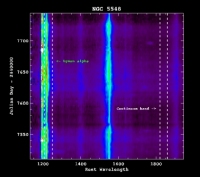Summary
IUE has been the most long-lived and (by a wide margin) the most productive satellite, so far, in the history of space astronomy. For more than 18 years it made, on average, one one-hour observation every 90 minutes, around the clock. It intercepted ultraviolet light that cannot reach telescopes on the ground, studying everything from far off supernovae to approaching comets. Key observations included Halley's Comet during its 1986 visit, a supernova event in a nearby galaxy in 1987, and Comet Shoemaker-Levy crashing into Jupiter in 1994.
During IUE's life, more than 1000 European observing programmes were conducted from Villafranca, returning more than 30 000 spectra from about 9000 targets, extending from Comets to far away quasars at the early days of the Universe and covering a brightness range of 10 orders of magnitude (extending from MV=-4 to MV=21).
 |
|
UV spectra of NGC 5548 |
Until operations finally ceased on 27 September 1996, astronomers were still queuing up to use an instrument that worked non-stop since its launch and continue to work with the wealth of data now stored in the IUE final archive.
